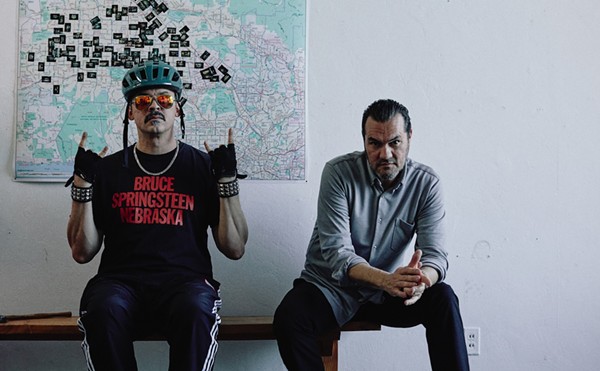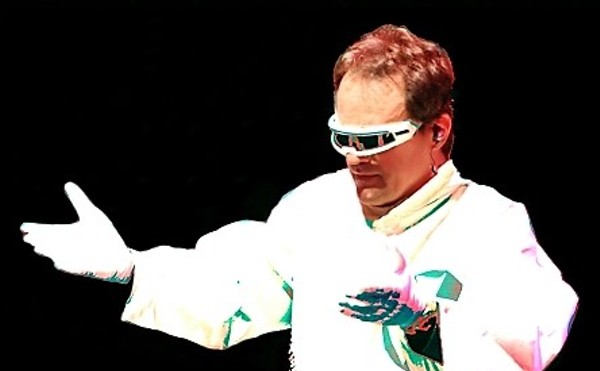Further, as a genuinely tortured artist (an always-helpful trait in securing one's status as a bona fide cult figure), Johnston's the real deal. His manic depression, the result of a chemical imbalance that has, in the author's words, found him seesawing between "creative outbursts and dead depressive years," is discussed fully here without overshadowing the book's well-balanced picture of Johnston's artistic endeavors.
Creative as a child, Johnston began drawing comics at age eight (an interest that later helped ease the pain of his adolescent depression) and, with his discovery of the Beatles, found new passion in music. Johnston also discovered what would turn out to be his muse in the form of a woman named Laurie, whom he met at Kent. Though their relationship was brief and platonic (she was engaged at the time to the son of the local undertaker), Laurie has been the inspiration behind what the author calls "songs documenting 20 years of obsessive unrequited love." Johnston's continuing fascination with a woman he hasn't seen in 18 years prompts one of Yazdani's periodic analytical musings: "Sometimes a muse takes on a life of its own, far removed from its source, never changing, frozen in crystal clear remembrance, as if the power of creative devotion has produced a living entity from a cherished long-ago experience."
Johnston quickly became a fixture of Austin's hipster scene, receiving some well-deserved exposure when MTV came to Austin in 1985 and filmed him for a show called The Cutting Edge. By the following year, he had been voted Best Songwriter and Best Folk Artist in the Austin Chronicle readers' poll. Since then, Johnston's songs have found their way into various movie and TV soundtracks; been covered by prominent Austin bands such as the Reivers, the Butthole Surfers, and Glass Eye; and even received airplay on college and renegade radio stations. From the crude simplicity of his recording debut, 1980's Songs of Pain, to his more recent recordings, with their higher-grade production values, Johnston, Yazdani notes, has "compulsively followed his heart, expressing the contents of his soul with a purity that has yet to be matched by anyone in rock and roll."
In these pages, the author provides a well-balanced overview of Johnston's creative output, including his artwork -- many examples of which are included here. His cartoon-like illustrations (populated with characters that often appear in his songs) depict a world in which concepts of good and evil are clearly defined -- a lingering influence, no doubt, from his strong Christian upbringing. Johnston's dramatic black-and-white line drawings, with their female torsos imbued with supernatural powers, superheroes, and bad guys (the latter often in the form of menacing devils), compose largely chaotic images that virtually scream with emotional intensity. In a separate chapter, Yazdani examines in greater depth the various characters, which include the pure innocence of Jeremiah the Frog, Joe the Boxer, the everyman "trying hard to defeat his demons," and the compassionate Casper the Ghost, who regularly lends a helping hand to those in need.
Though the childlike nature of his drawings prompts the author to wonder whether Johnston suffers from "some perhaps undiagnosable form of arrested development," his style of art (which falls into the "outsider" or "visionary" category) enjoys its share of devotees and has found its way into art exhibitions in the U.S. and Europe. Unfortunately, Johnston's creativity has often been derailed by the effects of his mental illness. Lax in taking his medication over the years, Johnston has endured numerous psychotic episodes and hospitalizations. During one delusional episode, Johnston once tried to wrest control of the plane his dad was piloting, believing him to be under the command of Satan, thus forcing the elder Johnston to crash-land in an Arkansas field.
Still, Johnston has proven to be quite productive in his more stable moments and, further, has benefited greatly from friends, fellow musicians, and supporters who have helped get his name out to the public. Though Johnston dreams of mainstream success, Yazdani concedes that's not likely to happen, given that the now overweight, graying Johnston is not exactly the stuff of teen dreams. Instead he seems fated to maintain his current cult status, which, in the author's words, "centers around his innocent ability to come off as anyone but himself, a strange, lonely, fun-loving kid trapped in a body that doesn't obey but follows warped rituals all its own."
The author includes few quotes from Johnston himself, instead allowing the plainspoken, often childlike lyrics of this most personal of songwriters to do the talking. The book's last chapter, devoted to the lyrics of some of his most popular songs, is a veritable window to Johnston's soul. Amid the numerous odes to unrequited love directed toward Laurie, there are songs inspired by his strong Christian background -- i.e., the verbatim quotation from I Corinthians 13:4-7 in "Love Defined," the stern warning of "Don't Play Cards With Satan" ("He'll deal you an awful hand"), and the moralism of "Don't Let the Sun Go Down on Your Grievances" ("Respect love of the heart over lust of the flesh").
Elsewhere, Johnston exults in the meaning and life's purpose he found in music in "Rock'N'Roll/Ega" ("You gotta have a reason/Something worth getting up in the morning for/My heart looked to art, and I found the Beatles/Oh God I was and am a true disciple") and laments the pressures of being an artist in "Like a Monkey in a Zoo" ("The days go so slow/I don't have no friends, except all these people who want me to do tricks for them like a monkey in a zoo"). Johnston's songs reflect the singer's mercurial moods, from the despair of "Desperate Man Blues" ("There ain't no fun in living anymore/And I don't feel much like living/Can't see what for") to the sheer guilelessness of "Happy Time," which sings the praises of Kool-Aid, candy bars, comic books, and bubble gum.
With its emphasis on Johnston's artwork and lyrics, and photos of Johnston over the years, Hi, How Are You? is a bio that almost has the feel of a scrapbook -- one that nicely pays tribute to the pure means of expression of a man Yazdani calls "a mixture of baffling innocence, childlike willfulness, and frighteningly adult anger."













